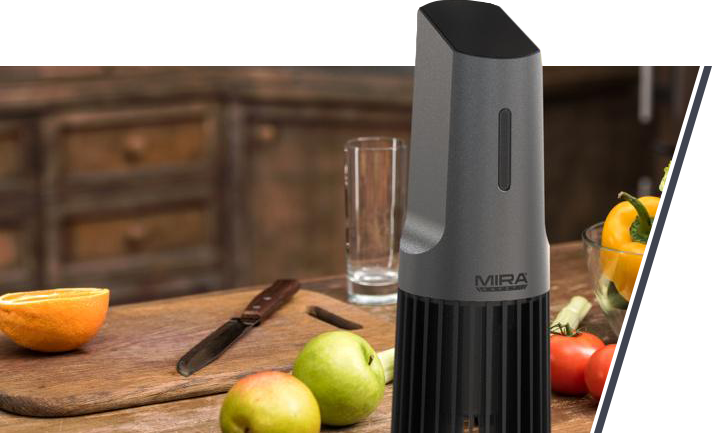Going to the local grocery store is a relatively innocuous activity. Millions of people do it daily in the United States alone, with little issue. But every once in a while, something happens that leads to the grocer becoming a potential source of infection. This type of infection rapidly gains steam throughout the community – a Listeria outbreak.

Soon, people begin to fall ill, news outlets pick up on the noise, and it seems as if everybody is afraid of eating lettuce. This is the nature of an outbreak, and its mysteriousness leaves many people wondering what to do.
Just what is this deadly disease? Where does it come from? And, more importantly, what can we do to prevent it? If these are some questions you find bouncing around inside your head, read on.
Let’s take a deep dive into the subject.
Read our breakdown on Organic Foods here to learn more about other popular dieting trends.
Table of Contents
-
01
What Causes Listeriosis?
-
02
What’s the Incubation Period of Listeriosis?
-
03
What Does Listeriosis Do to You?
-
04
What Are the Primary Sources of Listeria Outbreaks?
-
05
Who Does Listeriosis Impact the Most?
-
06
What Can You Do to Prevent Listeriosis?
What Causes Listeriosis?
A particularly hardy little bacteria known as Listeria monocytogenes is the culprit here. A typical bacterium within the environment, typically L. monocytogenes, can be found in one of three places: soil, water, or manure.

So how does listeria get in food? If you come down with a case of listeriosis, your food is either directly or indirectly tainted by one of these three sources.
And that's where things get tricky. Because L. monocytogenes is so hardy, you don't even have to see the dirt or poop to get sick. All it can take is eating something that came in contact with the wrong meat slicer, countertop, or pair of hands. Do that at the wrong place and time, and you could quickly regret some of your recent decisions.
And to make matters even worse? The incubation period of Listeria can result in a nightmare for epidemiologists attempting to track things back to the source.
A NOTE OF INTEREST
There’s a chance that L. monocytogenes may be a spillover infection that started in animals and found its way into humans. It was first discovered in 1926 in animals but was later found to be a cause of human illness in 1981. So, was L. monocytogenes something that we didn't realize was causing people to get sick throughout history, or, at some point within that 60-year window, did L. monocytogenes make the jump to human beings?
What’s the Incubation Period for Listeriosis?
Typically, you're looking at a 2–3-week incubation period with this little bug. Of course, there's a lot of variation here. Many people can show signs of illness within hours after eating the contaminated food and will show signs and symptoms for about three days. But, there have been cases reported where the incubation period was as long as 70 days.
Listeria outbreaks follow their own timetable for making people sick. Therefore attempting to collect information on what somebody ate three weeks ago could prove challenging to determine what made them ill today.
What Does Listeriosis Do to You?
If you’re a healthy, young individual, the odds are that it won’t do much to you at all. Many Listeria cases are asymptomatic, meaning the “sick” person won’t ever show any signs of being sick.
However, that’s not a guarantee. Out of all the foodborne illnesses that one can contract, listeriosis is the one that’s statistically most likely to put you in the hospital. (It’s also the third most likely foodborne illness to kill you.)
In minor, symptomatic cases, signs and symptoms include:
-

Fever
-

Headache
-

Muscle aches
-

Diarrhea
In more severe cases, the patient may exhibit or experience the following:
-

Stiff neck
-

Sudden onset of meningitis
-

Delirium/confusion
-

Loss of balance
-

Seizures
-

Miscarriage
Without prompt, professional medical care, death can be the end result. The case-fatality rate for listeriosis is between 20-30% in Europe and approximately 18% in the United States, meaning this can be a very severe illness to contract.
A NOTE OF INTEREST
Foodborne illnesses kill 9000 people annually in America and cause 6.5 – 33 million cases of illness/per year.
What Are the Primary Sources of Listeria Outbreaks?
L. monocytogenes can pop up just about anywhere. Still, virtually all listeria cases are caused by eating contaminated food. Listeriosis outbreaks are associated with everything from cantaloupes to enoki mushrooms.

Some of the listeria outbreaks we've seen have originated from:
-

Cantaloupes, 2012 – 147 cases, 143 hospitalizations, 33 dead, one miscarriage
-

Soft cheese, 2015 – 30 cases, 28 hospitalized, three dead, one miscarriage
-

Deli ham, 2018 – 4 cases, four hospitalizations, one dead
-

Enoki mushrooms, 2020 – 36 cases, 31 hospitalized, four dead
-

Ice cream, 2022 – 28 cases, 27 hospitalized, one dead
-

Enoki mushrooms, 2022 – 2 hospitalized
-

Deli meats/cheeses, 2022 – 13 hospitalized, one miscarriage
-

Packaged salad, 2022 – 18 cases, 16 hospitalized, three dead
While this is just a sampling of some of the Listeria outbreaks we’ve seen ever since its discovery, there are trends that epidemiologists have discovered.
Deli meats, cheese, and vegetables are typically the leading cause of a listeriosis outbreak.
We can expand a bit on this, however.
Deli meats
Various types of cold-cut meats have repeatedly been tied to listeria outbreaks. For example, one 2003 Listeria outbreak in the United Kingdom was found to have originated from ready-to-eat sandwiches in a hospital retail outlet. A later 2008 listeria outbreak in Canada was also directly connected to eating contaminated deli meats.

Listeria contaminated deli meat. Image courtesy of Wikimedia Commons.
Cheeses
Typically, it's soft cheeses that are the type of cheese responsible for an outbreak of Listeria. Feta, brie, camembert, chevre, pate, and blue cheese are some of the soft cheeses that have been responsible for the episode. If you're going to eat one of these cheeses, consider picking up a pasteurized type unless you know and trust the farmer/cheesemonger.

Mexican-style soft cheeses have been responsible for several listeria outbreaks as well. Queso fresco, in particular, has been identified as a common source of infection.
Most of these cheese-origin Listeria outbreaks come from eating unpasteurized cheese. There's a 50-160% increased risk of L. monocytogenes presence with unpasteurized soft cheese products compared with pasteurized versions. By simply transitioning to pasteurized cheeses, there's a much lower risk of becoming sick from eating contaminated cheese.
A NOTE OF INTEREST
Listeriosis outbreaks tend to happen in the summer months, with one study of 26 listeria outbreaks in America finding that 46.2% of them took place in June, July, and August. The increased outside activity among the population, where contact with dirt coupled with the consumption of summertime foods such as hotdogs, were often touted as potential causes of listeriosis.
Given the prevalence of backyard barbecues during this time of the year, this stands to reason.
Who Does Listeriosis Impact the Most?
While anybody can get listeriosis, some population segments are more likely to get sick than others. These are the elderly, pregnant women, newborns, and the immunocompromised. Anybody that falls into one of these categories is at a significantly higher risk of experiencing severe adverse health consequences due to a listeriosis infection.
Pregnant Women
Of these high-risk groups, pregnant women need to be careful with avoiding listeriosis, as they have a ten times higher chance of contracting the disease than the rest of the population. Mexican women who are pregnant heighten those chances even further due to increased consumption of traditional Mexican foods such as queso fresco, a soft cheese known as a potential spreader of listeriosis.

It's not that the disease tends to be terrible for the mother itself – pregnant women primarily report mild symptoms – it's what the condition will do to the baby they are carrying. Pre-term labor is only one of the possible results that the two will experience, and the rest can be far worse.
Babies
Newborns are at an exceptionally high risk of developing listeriosis and almost always developing meningitis with a case of Listeria. They experience a 20-30% fatality rate that approaches 50% if the baby is diagnosed with the infection within four days of birth.

When babies contract listeriosis, they will show little interest in feeding, become irritable, have a fever, be nauseous, and even vomit. If a baby ends up with Listeria, there is little to no evidence that they would have contracted it by drinking breastmilk from an infected mother, as Listeria doesn't appear to spread in this manner.
The Immunocompromised
People with poorly functioning immune systems are at a higher risk of catching every pathogen out there. Their inherent defense mechanisms do not work properly to fight off the myriad of bacteria, viruses, and other pathogens the body encounters daily. Fighting off Listeria can prove to be difficult for them.
In particular, people who are on a regular regimen of corticosteroids, have diabetes, heart disease, renal disease, or have had organ transplants are at an increased risk of developing Listeria.

The Elderly
Infection to the elderly is where the bulk of listeria cases take place. If you hear that somebody has listeriosis and you learn they're not pregnant, the odds are that they're older. In fact, less than 20% of all Listeria cases are in pregnant women. The elderly population is the one who historically bears the brunt of the caseload.
How is Listeria Treated?
Doctors typically will give the patient an IV treatment, likely containing penicillin, ampicillin, and aminoglycoside. If the patient suffers from a penicillin allergy, the doctor will likely give erythromycin or trimethoprim-sulfamethoxazole (Bactrim, Sulfatrim.)
So, thankfully, if somebody does end up contracting Listeria, it's not a hopeless case, and there is still plenty that the doctor can do for them to improve their chances.
What Can You Do to Prevent Listeriosis?
While L. monocytogenes is a pervasive little bug, it is not invincible. There are a large number of things that you can do to reduce your risks of a listeriosis infection significantly.
Let's take a look at what some of those methods are.
Keep Your Kitchen Clean
First and foremost, keep your kitchen clean. Approximately 58% of all listeria outbreaks originate in the home, showing that it is vital that you make sure that you are regularly cleaning your countertops, cutting boards, kitchen table, sinks, and washing your dishes.
This simple household chore will not only make for a cleaner home but for a healthier family as well.

Wash Your Hands Before You Eat
Next, ensure you wash your hands before eating or even preparing your food. As mentioned above, L. monocytogenes likes to live in soil and feces. If you just worked in the yard or were brushing the dog, you could transfer L. monocytogenes to your food. Washing your hands before eating or preparing food helps minimize this risk.
This simple activity only takes a minute to accomplish and can keep you safe from a wide range of illnesses, so there’s no reason not to take this simple precaution.
Heat Those Leftovers Hot
One of the things that makes L. monocytogenes so tricky is that, unlike many other types of bacteria, it can continue to grow and contaminate food in the refrigerator. Cold doesn’t hinder L. monocytogenes, and it can even survive freezing.
But it does have a weakness: heat.
Experts recommend that you heat your leftovers until they are steaming hot, mainly if you are a high-risk individual. Doing so helps kill off Listeria germs, making for a happy meal and a happier gut.
Avoid Certain Foods If You Are High Risk.
Specific food avoidance is most important for pregnant women. All deli meats, soft cheeses, and raw, unwashed veggies are strongly advised against consumption. Because miscarriage is a common effect of listeriosis, the risks are too high to be passive here.

(Image source: Image courtesy of Wikimedia Commons.)
Wash Your Fruits and Veggies
Washing your fruits and vegetables is another crucial step you can take, and this is where MIRA Safety can help you out. While vegetables are a common source of Listeria outbreaks, fruits can also be the cause. Vegetables are likely the predominant source between these two food groups because they tend to be crops close to the ground soil compared to fruit, which often grows on trees. There are exceptions to this (e.g., strawberries, melons, etc.), but it is a helpful rule of thumb.
An example of the deadliest Listeria outbreak we've seen to date was traced back to cantaloupes grown on one farm in 2011.
Like it or not, manure is a regular addition to farms everywhere. The problem comes when some farmers apply manure to their fields when produce grows nearby, and that manure can then contaminate the crop, causing an outbreak.
So, wash your fruits and veggies before you eat them.
Use the MIRA Safety DTX-1 Food Detoxifier
The MIRA Safety DTX-1 Food Detoxifier can help you in this process. By simply tossing your fruits and veggies into a bin of water and using our Detoxifier, you will blast the exterior surfaces of your food with ozone, which kills the majority of bacteria out there. L. monocytogenes being a bacteria, doesn't fare well when exposed to ozone either.

While we haven't explicitly tested the MIRA Safety Food Detoxifier against Listeria (yet), consider the following:
-

In 1997, the FDA listed ozone as a Generally Recognized Safe (GRAS) substance.
-

In 2001, the FDA approved ozone as an antimicrobial agent.
-

Ozone has been found to inactivate 99% of pesticides and most microorganisms.
-

Ozone breaks down into oxygen within 10-20 minutes and leaves no dangerous residue on the food.
-

The only byproduct of ozone degradation is oxygen.
-

Chlorine is the most common produce disinfectant. Ozone is 1.5x more potent than chlorine and kills a broader swath of microorganisms.
-

Chlorine is known for leaving behind byproducts that can harm human health.
-

Ozone has been found to kill Listeria.
-

Ozone is found to kill Listeria much faster than chlorine can.
-

Ozone can destroy chlorine byproducts.
-

Aqueous ozone penetrates a few millimeters into food, helping to clean beyond the surface.

The Bottom Line
Thankfully, Listeria outbreaks are relatively rare. They happen every year, and the bacteria that cause the infection are everywhere, but there are so many things you can do to stop it in its tracks that it isn't as difficult to control as many other illnesses are.
However, one should not simply dismiss this threat, particularly if you're pregnant. If this is the case, you can and should do things to minimize your risk of infection, and following the above will help you do just that.
So don’t fall into hysteria worrying about Listeria. It’s not a hopeless case.
What are your thoughts? Have you ever had Listeria? Has anybody you know been the victim of a listeria outbreak? Let us know what you think in the comment section below.





